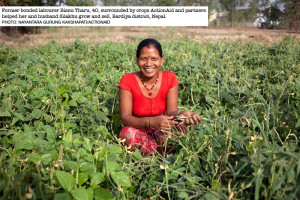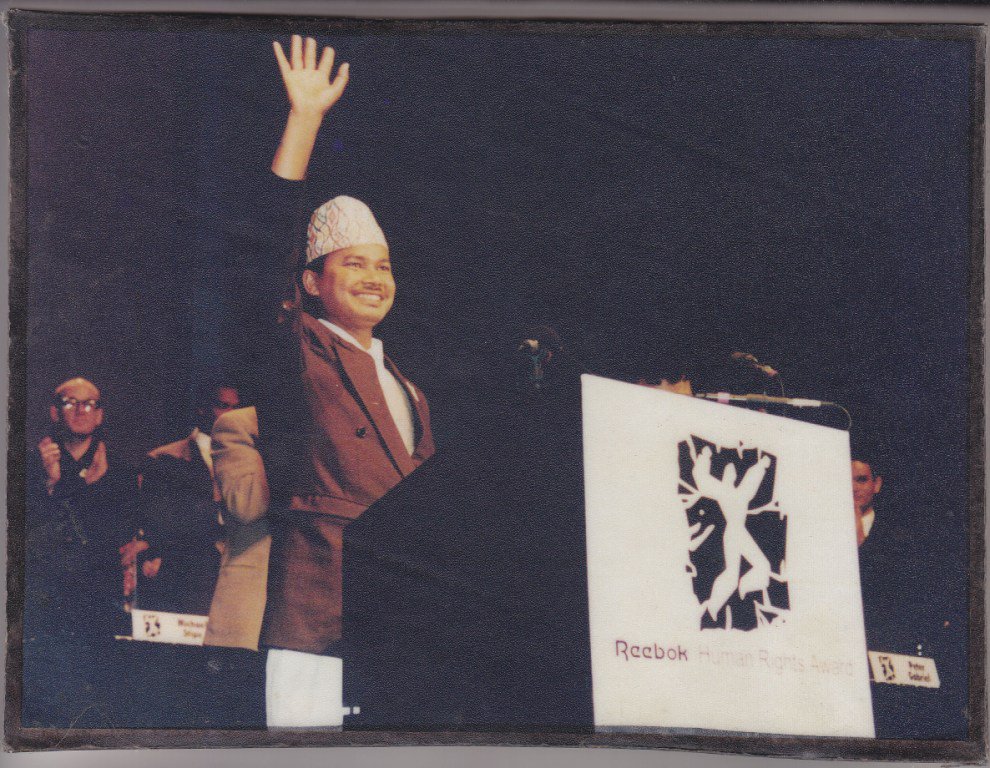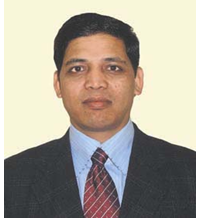Rehabilitation Status
Rehabilitation Status
Rehabilitation
It was provisioned to provide monetary support of Rs. 10,000 and 75 cu. ft. of timber to each of the freed Kamaiya as rehabilitation support to build own house in the camp in financial support of ILO. But aphorism is that most of the families neither got the money nor the timber. Those who received it, was up to Rs. 8,000 and 35 cu. ft. of timber. The area of use of the received support was either to buy a rickshaw or a bullock and some for household expenses (Ban, 2002) even selling the got timber. The survey unveiled the fact that about 68 and only 20 per cent of the ex-Kamaiya families received monetary and timber support respectively to build house. In terms of amount of money received, about 42, 25 and two per cent respectively received Rs. 10,000, 8,000 and 9,000. According to district of survey, highest proportion (98%) of the families received the monetary support in Kanchanpur followed by Bardiya. Proportion receiving the support is lowest in Banke (53% non-receivers).
All households in Dang received Rs. 8,000 as monetary support, whereas 34 per cent each in Banke and Bardiya and 68 and 73 respectively in Kailali and Kanchanpur received Rs. 10,000. About 11 per cent households in Bardiya said to receive Rs. 9,000 as rehabilitation support
Distribution of ex-Kamaiya Families According to Amount of Money and Timber Received as Rehabilitation Package by Survey District
| Receipt of Money and Timber | Dang | Banke | Bardiya | Kailali | Kanchanpur | Total | |
| Receipt of Money | |||||||
| Rs. 8,000 | 57.5 | 13.8 | 27.5 | 0.0 | 24.1 | 24.6 | |
| Rs. 9,000 | 0.0 | 0.0 | 11.3 | 0.0 | 0.0 | 2.3 | |
| Rs. 10,000 | 0.0 | 33.8 | 33.8 | 67.5 | 73.4 | 41.6 | |
| Non Receivers | 42.5 | 52.5 | 27.5 | 32.5 | 2.5 | 31.6 | |
| Avg. Money Received (Rs.) | 8,000 | 9,421 | 9,086 | 10,000 | 9,506 | 9,249 | |
| Amount Timber Received | |||||||
| 20 Cu. Ft | 0.0 | 0.0 | 0.0 | 6.3 | 0.0 | 1.3 | |
| 35 Cu. Ft | 56.3 | 8.8 | 0.0 | 22.5 | 5.1 | 18.5 | |
| Non Receivers | 43.8 | 91.3 | 100.0 | 71.3 | 94.9 | 80.2 | |
| Average Timber Received (cu.ft) | 35.0 | 35.0 | 0.0 | 31.7 | 35.0 | 34.1 | |
| Total HH (N) | 80 | 80 | 80 | 80 | 79 | 399 | |
Nearly 20 per cent households said to have received wood/timber to build house (about one per cent of total and 6% of Kailali said to have received 20 cu.ft). Above 50 per cent of the ex-Kamaiya households in Dang and some 29 per cent in Kailali received timber support and it is none in case of Bardiya. Only about nine and five per cent households respectively of Banke and Kanchanpur claimed to have received timber support to build own house in the land given for re-settlement.
Current land ownership status of ex-Kamaiyas is determined by the land given by government to them as rehabilitation support. As a part of liberation movement, the freed Kamaiyas demanded 10 Kattha land for per freed Kamaiya family, but the government promised to give maximum of five Kattha depending the location/site of the land to be distributed. The land re-distribution programme for the freed Kamaiya made the location based criteria of land area (in Kattha) to be given per family as:
- Land within municipality or adjacent to highways – maximum of 1 Kattha (338.63 sq. m.)
- Land around highways – maximum of 2 Kattha (677.26 sq. m.), and
- Land in rural areas- maximum of 5 Kattha (1,693.15 sq. m.)
The land re-distribution programme distributed land to the freed Kamaiyas mostly state owned land confiscated through:
- Surplus land from land ceiling,
- River banks i.e. lands reclaimed from the changed course of river, stream,
- Un-used land registered in the name of the government agencies and suitable for distribution,
- Land purchased by the government during previous efforts,
- Forest land with little or no forest cover, and
- Land gained from the eviction of informal settlers or illegal encroachment.
Land re-distribution program targeted only the freed Kamaiya families categorized to get red and blue[1] ID cards as eligible to get land from government. As of 2002 the programme enumerated a total of 27,500 freed Kamaiya families of class A (Red=15,500) and B (Blue=12,000) in the five affected districts of Kamaiya system (Table 4.5). From the table it is evident to see that of the total 27,570 ex-Kamaiya families, 1,712 (or 6%) still have not received any land from land re-distribution programme and the proportion of non-receivers increases to 10 per cent (3,324 households) of the total 32,500 ex-Kamaiya families living in five districts affected of Kamaiya system.
Distribution of ex-Kamaiya Households According to Land Receiving Status by Type of Identification and Districts
| Land Receiving Characteristics by ID Type | Dang | Banke | Bardiya | Kailali | Kanchanpur | Total |
| Total Families by Type | ||||||
| Red | 302 | 1,118 | 6,469 | 3,758 | 3,923 | 15,570 |
| Blue | 403 | 803 | 5,082 | 5,217 | 495 | 12,000 |
| Total (Red + Blue) | 705 | 1,921 | 11,551 | 8,975 | 4,418 | 27,570 |
| Yellow + White | 721 | 395 | 2,948 | 787 | 88 | 4,939 |
| Total Ex-Kamaiya | 1,426 | 2,316 | 14,499 | 9,762 | 4,506 | 32,509 |
| HHs Received Land | ||||||
| Red | 278 | 1,118 | 6,322 | 3,502 | 3,923 | 15,074 |
| Blue | 202 | 803 | 5,082 | 3,683 | 495 | 10,264 |
| Yellow + White | 27 | 226 | 2,527 | 207 | 88 | 3,074 |
| Total Land Receivers | 507 | 2,147 | 13,931 | 7,392 | 4,506 | 28,412 |
| HHs Not Received Land | ||||||
| Red | 24 | 0 | 147 | 256 | 0 | 496 |
| Blue | 201 | 0 | 0 | 1,534 | 0 | 1,736 |
| Yellow + White | 694 | 169 | 421 | 580 | 0 | 1,865 |
| Non Receivers | 919 | 169 | 568 | 2370 | 0 | 4,097 |
Substantial number of eligible families (received Red and Blue ID cards) to get land from the government sponsored programe is found abstained from the opportunity in Kailali and Dang districts and families with all identification status availed the land in Kanchanpur. This indicated that the government’s promise remained only in words for sizable ex-Kamaiya families in a number of instances.
The Present Status of Ex-Kamaiyas
The years long movement of Kamaiya liberations from the local to national level and showed togetherness by numbers of national and international civil societies and right based organizations (including BASE), protests and sit-ins before of the local administrative offices to Prime Minister’s office in Kathmandu compelled government to announce on July 17 2000 the Kamaiya System illegal and the practice henceforth punishable. Efforts to do away with the Kamaiya system gained strength, as the Kamaiyas themselves gradually became aware about how they had been exploited by their landlords. The movement certainly resulted in empowering the Kamaiyas by publicising the issue and by putting a pressure on the government to take necessary action (Chhetri, nd.). Government made following four legal provisions in declaring Kamaiya liberation as (Kattel, 2000).
- the engagement of kamaiya labor is illegal,
- the kamaiyas are emancipated outright,
- any written or verbal contract made between the landlord and the kamaiya or a family member is null and void and its enforcement punishable by law, and
- the debt (saunki, in local term) under the kamaiya system is illegal and therefore should not be paid back.
But, the problems of the ‘free Kamaiyas’ do not seem to have come to an end. After of the liberation, the ex-Kamaiya still suffers from the pains accumulated during the several generations of living under the system. The weak provisions of re-settlements and rehabilitation and employment and livelihoods protection further aggravated their living standards. The state has not yet been able to rehabilitate them and supply them with basic subsistence needs. Kamaiyas have either left or have been forced by their masters to leave the huts constructed in the land of their masters.
The government announced to allocate small piece of land, give up to a certain volume of timber and some money[2] to each of the freed Kamaiya families to enable them to build their own living home in the newly acquired lands. But the reality is different since, freed Kamaiyas were verified/certified on the recommendation of the landlords; because some of the freed Kamaiyas could not be verified their master’s revenge or cunning nature and some non-Kamaiyas been able to obtain certification. The freed Kamaiyas were classified into four categories and issued ID cards of different four colors according to categories. Those homeless and land less Kamaiyas were placed in class A and issued the red ID card. Those who have own living home in public land issued the blue ID card. Those who had a plot of land up to the size of 2 Katthas with own home there were given yellow ID card and those who had a plot of land larger than 2 Katthas and living in own house given white ID card (Table 1). However, there were indications that distribution of ID card was also biased. Therefore, it is claimed that the life experiences or situation of many ex-Kamaiya at present is described well by the saying ‘from the frying pan into the fire’ (Chhetri, nd.).
Table 1: Categorization Schemes of ex-Kamaiya families by Land and House Possession/ownerships Status and Type of ID Cards to be issued
| Group | Attributes of the group | Type of ID Card |
| Group A | The household having no land at all and residing at the house provided by the taking landlord | Red |
| Group B | The household occupying informal land with a house for living but having no registered land | Blue |
| Group C | The household having less than 2 kattha (677.26 sq. m) of registered land and having own house | Yellow |
| Group D | The household having more than 2 kattha (677.26 sq. m) of registered land and having own house | White |
Source: Bhatta, 2009 and Katel, 2000.
First and foremost, the lack of employment opportunities for the ex-Kamaiyas outside the landlords’ farms makes them more vulnerable. The intergenerational skill they possessed was doing the agriculture as per seasons but their eviction from master’s house detached them from land relation and the ex-Kamaiya families turned into homeless and jobless”. Un-planned announcement of the ‘freedom’ ended the relationship of the Kamaiyas with the agricultural activities of their survival and with production system—-even though the relationship was in exploitative intermediation. The skilled and hard-working agriculturists not only turned into “non-productive” category of people but also left with no alternatives of livelihood (Chhetri, nd.; Ban, J., 2002). Some returned to the same landlords entering into other forms of exploitative contract while others are forced to take any kind of casual work (including rickshaw pulling) available in the nearby urban centres. As consequence of joblessness and income insecurity many of the ex-Kamaiya parents found their children as alternatives of livelihoods and sent back children to work in the landlord’s place to work as Kamlhar/Kamlahri[3]; as hotel/ restaurants boys/girls; child domestics in major urban centres[4] and other worst/hazardous forms of child labour at the cost of schooling. Further aggravated livelihood situation of ex-Kamaiya families and introduction of new forms of enslavement of their children raised a question whether the government’s announcement of Kamaiya liberation was to resolve the inhuman practices of un-free and exploitative system of labour contract or to shift the problem elsewhere than being solved.
Mean while, the escalated civil conflict (intense in the Kamaiya practice affected districts) in the country is accused to slow-down the delivery of development assistance to the target communities. The local labour market of subsistence sector was already saturated to create additional job opportunities. Ex-Kamaiya identification programme was not effective from the very beginning. During the initial years, many more ex-Kamaiya families were not covered in the identification records and have come forward aftermath of the initial identification process, claiming also to be Kamaiyas. About 14,000 additional ex-Kamaiyas families identified (evident from Table 2) later to have failed to receive any assistance from the concerned agencies of Nepal Government and other support agencies (UN or bi-lateral). These families have still not received identity cards to formally claim own-self as ex-Kamaiyas and ensure the rights to land and other rehabilitation support including health services and support for children’s education (MS website, 2005).
In conclusion it has been claimed that the Government did provide land to some of the freed Kamaiyas but failed to provide them with shelter. Even after 8 years of their liberation, many are still waiting to get the Promised Land from the government. Those who have received land are also staying in unhygienic and temporary shelters as they cannot afford to build a proper house. Until now, the Government has been unable to rehabilitate them as promised. In summing up, lacking proper housing, living in temporary shelters made of plastic sheets, clothes, bamboos and thatches afflicted of diarrhoea, cholera and typhoid are rampant. There is only limited clean drinking water and sanitary practices are poor. Within this context, children are at first place of victimization of nutrition, health and education.
As of 2002 it has been identified a total of 32,500 (of all categories) Kamaiya families in five affected districts under four categories (Table 2). Bardiya is the districts with highest practices of Kamaiya System in all periods of observation followed by Kailali (Table 2). But visible increase in Kamaiya family during the years following of emancipation is apparent from Table 2.
Table 2: Size of Kamaiya Families by Districts of effect and Year of Observation
| Districts | 1995 | 2000 | 2002 |
| Dang | 1,856 | 1,166 | 1,426 |
| Banke | 1,060 | 1,345 | 2,316 |
| Bardiya | 5,037 | 6,949 | 14,499 |
| Lailali | 5,557 | 5,895 | 9,762 |
| Kanchanpur | 1,642 | 3,045 | 4,506 |
| Total | 15,152 | 18,400 | 32,509 |
Source: Bhatta, 2009
In all districts concerned there is an estimated 22,000 freed Kamaiya households and the total population is estimated at about 100,000. Besides the Kamaiyas, the recent years have seen a migration from the hills to the Terai. The reasons for this are several but, difficult living conditions and problems, in general, and growing sufficient food in the Mid Hills, are the main causes of the influx; the possibility of acquiring fertile farmland or finding work in the urban areas; and recently many have been caught and/or exploited in the conflict between the police and Maoists. Some of the migrants are too poor to buy land for themselves and they have to rely on the government distribution of land for the landless.
For the Kamaiyas, their living conditions have been so difficult that they have had to send their children to work in hotels, brick factories, farms etc. to feed themselves and to earn a small income for the families. According to a 1996 study carried out by INSEC, 10% of Kamaiya children attended school. Recent estimates as regards the children in the camps show a 2-3% attendance in primary schooling; this is underscored by the striking absence of youngsters and children of school-going age in the camps.
At the time of writing this proposal there was still uncertainties about whether settlement would have taken place and if so, whether the target groups would be put in new settlements or scattered throughout existing villages. However, the target groups have only just started occupying land and by doing so, they should, in effect, put pressure on those politicians and bureaucrats responsible for the distribution of permanent land for settlement.
In the event of it still not having been settled by the start of this project, the advocacy component could be adapted to mobilise the process and provide the foundation for the other project components.
[1] Families with no land and house and families with house built in public land – occupied informally
[2] Rs. 10,000 and 35 Cubic feet of timber
[3] As reported in Kantipur (Nepali National Daily) on January 2, 2003, some parents have sent their children back to the landlords to work as Kamaiyas In return for 1-2 quintals of rice paddy
[4] Aphorism was that during following years of Kamaiya liberation, size of Tharu children working as child domestic increased substantially in Pokhara, Kathmandu, Butwal and other major city centers in the country.



